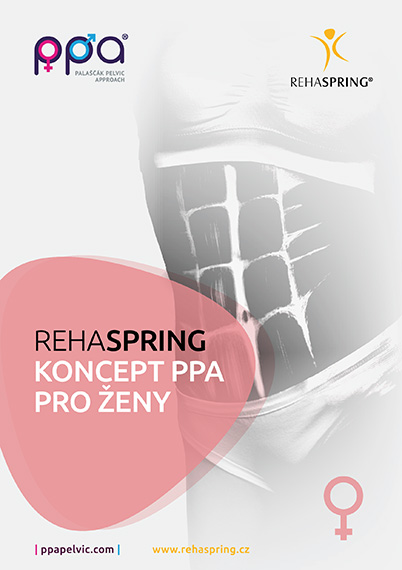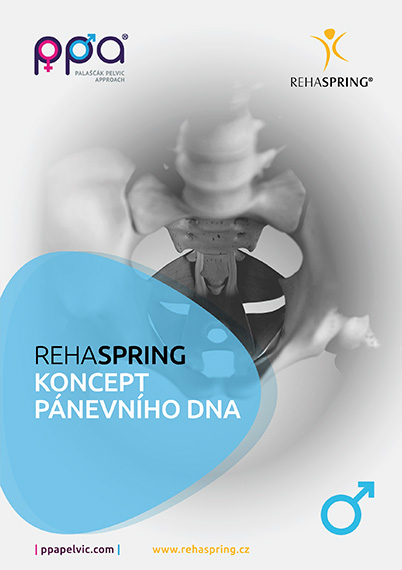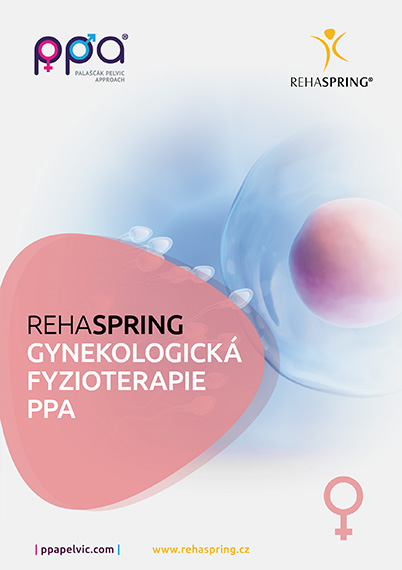Symptoms of pelvic floor dysfunction
Urinary leakage, descent of organs into the vagina, leakage of gas and stool, pain during intercourse are manifestations of pelvic floor dysfunction.
Information
View leaflets with information about therapy options
Physiotherapy for women
Indications, description of therapeutic procedures
Physiotherapy before pregnancy
- Who is the programme for?
For women who are planning to get pregnant now or in the future.
- The physiotherapist will evaluate the function of the pelvic floor muscles through the vagina (per vaginam)
- 2D ultrasound will show you the activity and relaxation of the pelvic floor muscles
- Based on the results of the examination, we will create an individual – functional or training plan for you
- We will recommend targeted training for pelvic floor muscle activation or relaxation
- We will teach you how to monitor ovulation
- Instruction on pelvic floor muscle massage and relaxation techniques to properly push out the newborn during delivery
- Training in pelvic floor muscle self-massage
Physiotherapy of painful menstruation and endometriosis
The first menstruation in girls may not be painful, but it can become painful over time. Women and girls should know that this is not a standard manifestation and they can address it. Today’s advances in physical therapy and devices are improving the quality of life for these women diagnosed with painful menstruation and endometriosis.
- Who is the programme for?
For women and girls who suffer from painful menstruation (dysmenorrhea) or have been diagnosed with endometriosis.
- The physiotherapist will evaluate the function of the pelvic floor muscles through the vagina (per vaginam)
- 2D ultrasound will show you the activity and relaxation of the pelvic floor muscles
- Based on the results of the examination, we will create an individual – functional or training plan for you
- We will recommend targeted training for pelvic floor muscle activation or relaxation
- We will recommend exercises to improve the overall physical functionality of the body
- We will improve the fitness required for your condition by selecting exercises suitable for you
- We work with our own and proven accredited procedures and methods
- The physiotherapist will evaluate the function of the pelvic floor muscles through the vagina (per vaginam)
Physiotherapy during pregnancy
- Who is the programme for?
The program is designed for pregnant women from 4 months of pregnancy to prepare for the period of pregnancy and childbirth.
- Exercise instruction and selection of appropriate movement patterns to prevent abdominal muscle separation – diastasis.
- Instruction on the regimen and selection of appropriate aids such as pregnancy belts, clothing…
- Individual instruction on a set of exercises to maintain fitness during pregnancy.
- Pre-natal preparation education on how labour takes place and what happens to the pelvic floor muscles during labour.
- Instruction on massaging the perineal area and practicing relaxing the pelvic floor muscles for labor.
- Training in the correct pushing of the newborn and correct and targeted pushing into the birth canal.
- Education to prevent birth and postpartum pelvic floor muscle injuries.
- Exercise instruction and selection of appropriate movement patterns to prevent abdominal muscle separation – diastasis.
Physiotherapy after childbirth and abdominal diastasis
- Who is the programme for?
For women who are at least 2 months postpartum and want to have the function of the pelvic floor muscles per vaginam and its structure checked after delivery with 3D/4D ultrasound.
- The physiotherapist will evaluate the function of the pelvic floor muscles through the vagina (per vaginam)
- 2D ultrasound will show you the activity and relaxation of the pelvic floor muscles after delivery
- Based on the result of the examination, we will design an individual plan to return you to your pre-birth state.
- We will recommend a targeted device to train your pelvic floor muscles when needed.
- We will measure the size of your abdominal diastasis using 2D ultrasound.
- Based on the results of the examination, an individual physical activity plan for the pelvic floor muscles and a gradual dosage of exercise will be recommended.
- We will show you the structure of the pelvic floor muscles with 3D/4D ultrasound of the pelvic floor after delivery and evaluate its postpartum defects (rupture avulsion).
- For successful therapy, you will need to have at least an initial examination and two follow-up visits at our specialized center within 4 to 8 months to evaluate the success of the therapy.
- The physiotherapist will evaluate the function of the pelvic floor muscles through the vagina (per vaginam)
Physiotherapy of urinary incontinence
- Who is the programme for?
For women who experience urine leakage during situations such as coughing, sneezing, sniffling, physical activity, jumping, lifting children, running and other activities. Urinary leakage may also be associated with urgency when women have the urge to urinate and subsequent urine leakage. Risk factors for urine leakage include menopause, higher BMI, pelvic floor muscle dysfunction (their inactivity).
- The physiotherapist will evaluate the function of the pelvic floor muscles through the vagina (per vaginam)
- 2D ultrasound will show you the activity and relaxation of the pelvic floor muscles
- We will show you the structure of the pelvic floor muscles with 3D/4D ultrasound and measure precisely the values that are essential for the subsequent therapy.
- Based on the result of the examination, we will design an individual therapy and a training procedure for your pelvic floor muscles.
- We will recommend targeted equipment to train your pelvic floor muscles and treat urinary leakage when needed.
- For successful therapy, a minimum of 3 visits to our specialist centre over a period of 4 – 6 months is required
- The physiotherapist will evaluate the function of the pelvic floor muscles through the vagina (per vaginam)
Physiotherapy of the descent of small pelvis organs
- Who is the programme for?
The program is designed for women who have symptoms of pelvic organ prolapse. During self–examination, they palpate the descent of the bladder or uterus, rectum. They may also have pain in the lower abdomen and/or feel heaviness in the vaginal opening especially towards the evening after a busy day.
- The physiotherapist will evaluate the function of the pelvic floor muscles through the vagina (per vaginam)
- 2D ultrasound will show you the activity and relaxation of the pelvic floor muscles
- We will show you the structure of the pelvic floor muscles with 3D/4D ultrasound
- Based on the result of the examination, the physiotherapist will design an individual exercise plan for you
- We will recommend and select a targeted device for training the pelvic floor muscles and compensating for the sagging of the pelvic organs – the right pessary or tampon.
- For successful therapy, a minimum of 3 visits to our specialist centre over a period of 4 – 6 months is required
- The physiotherapist will evaluate the function of the pelvic floor muscles through the vagina (per vaginam)
Physiotherapy for men
Indications, description of therapeutic procedures
Physiotherapy after RARP prostate surgery
- Who is the programme for?
Prostate cancer affects men most often after the age of 50. After prostate surgery, urine leakage is common.
–– Important –– Men should see a physiotherapist for individual instruction to understand exactly what to do with his pelvic floor muscles after surgery! The visit should be no more than 4 weeks before prostate surgery. Exercises cannot be learned from a booklet, but instruction will be taken per rectum and with a state-of-the-art ultrasound machine. Postoperative physiotherapy should be started within 1 month of surgery. The patient must have no postoperative complications and must have the catheter removed and be free of inflammation. Proper function of the pelvic floor muscles is important for urinary retention.
- The physiotherapist will analyse the initial condition with you and fill in questionnaires to monitor the progress of the therapy
- We will evaluate your pelvic floor muscle function using 2D ultrasound and per rectum.
- Based on the initial questionnaire and the evaluation of the pelvic floor muscle function, we will design an individual training and therapy for you.
- We will recommend targeted pelvic floor muscle training and urinary leakage therapy when needed.
- The physiotherapist will analyse the initial condition with you and fill in questionnaires to monitor the progress of the therapy
Physiotherapy of erectile dysfunction (ED)
- Who is the programme for?
Erectile dysfunction can result from peripheral nerve involvement during pelvic surgery – most commonly after radical surgery for prostate cancer. A decline in erectile dysfunction can be a functional problem in men as part of their lifestyle.
- The physiotherapist will analyse the initial condition with you and fill in questionnaires to monitor the progress of the therapy
- We will evaluate your pelvic floor muscle function using 2D ultrasound and per rectum.
- Based on the initial questionnaire and the evaluation of the pelvic floor muscle function, we will design an individual training and therapy for you.
- During the therapy we use for example rectal weights and biofeedback by ultrasound.
- The physiotherapist will analyse the initial condition with you and fill in questionnaires to monitor the progress of the therapy
Physiotherapy of anorectal dysfunction
- Who is the programme for?
Poor diet, Crohn’s disease, rectal surgery, irritable bowel, constipation and diarrhea are common symptoms of anorectally dysfunctional patients.
Program for anorectal patients:
- The physiotherapist will analyze the initial condition with you and complete questionnaires to monitor the progress of therapy
- We will evaluate your pelvic floor muscle function using 2D ultrasound and per rectum.
- Based on the initial questionnaire and the evaluation of the pelvic floor muscle function, we will design your individual training and therapy.
- We will recommend targeted pelvic floor muscle training and urinary leakage therapy when needed.
- The physiotherapist will analyze the initial condition with you and complete questionnaires to monitor the progress of therapy
Physiotherapy of diastasis of the abdominal muscles and inguinal hernia
- Who is the programme for?
The risk factor for the development of excessive spacing of the abdominal muscles in men is most often pelvic floor muscle dysfunction, abdominal muscle dysfunction, obesity. Abdominal muscle spacing can be described as a precursor of abdominal hernia.
- The physiotherapist will analyse the initial condition with you and fill in questionnaires to monitor the progress of the therapy
- We will evaluate your pelvic floor muscle function using 2D ultrasound and per rectum.
- We will measure your abdominal muscle spacing using 2D ultrasound.
- Based on the initial questionnaire and evaluation of pelvic floor and abdominal muscle function, we will design an individual training and therapy for you.
- We will recommend a targeted pelvic floor muscle training device when needed.
- The physiotherapist will analyse the initial condition with you and fill in questionnaires to monitor the progress of the therapy
In our centre we work with the accredited gynaecological-urological concept of the Ministry of Health of the Czech Republic PPA (Palaščáková Pelvic Approach), whose author is PhDr. Ingrid Palaščáková Špringrová, PhD. – a specialist in urogynaecology and an expert in 2D and 3D/4D ultrasound examination of pelvic floor muscles
Our professional and expert competence includes evaluation of pelvic floor muscle function and dysfunction and treatment of symptoms associated with pelvic floor muscle dysfunction such as urinary incontinence, pelvic organ prolapse, abdominal muscle separation, anorectal dysfunction, dysmenorrhea and endometriosis. Our centre is equipped with state-of-the-art diagnostic ultrasound equipment for examinations and therapies. PPA physiotherapists at our centre use the centre’s proven procedures in diagnosis and therapy is guided by clinical and scientific protocols and procedures.







